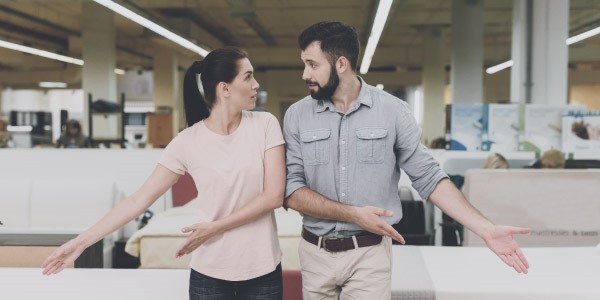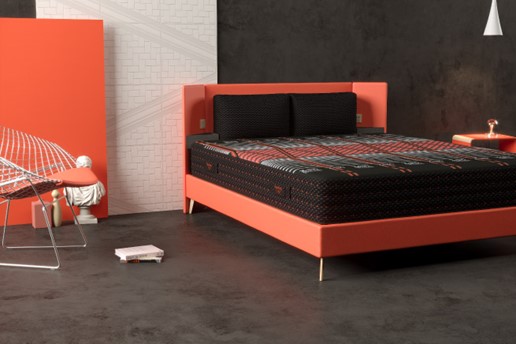
That's it, it's time to change the old mattress. You've finally made the decision but now you're wondering: how to proceed?
Choosing a new mattress presents many pitfalls and the real risk of ending up with a product that is inadequate for your needs or even harmful to your health. That is why getting informed is essential, so that we understand the factors that determine well-being and affect the quality of our lives.
Often those who choose to purchase a mattress are faced with an initial crossroads. The question is always the same: spring mattress or memory mattress, which is better? How to choose the right mattress?
First of all, some clarity: here we are talking about the internal structure or core of the mattress, not to be confused with other elements such as padding or upholstery. The internal structure is responsible for support, that is how and to what extent the mattress supports the body.
Having established that, let's look at the differences and understand what is different between a spring mattress and a Memory mattress. A little preview of what follows: memory mattresses do not exist!
Memory mattress...or foam?
Everyone talks about Memory mattresses. Yet, the Memory mattress does not exist!
Memory is a fine polyurethane foam (i.e. a foam) with special properties: porous, it has a very high density and is temperature sensitive, that is it reacts to body heat by expanding and "memorizing" its shape. Once the body pressure is over, it returns to its original state.
Because of these specific properties, Memory is ideal as a filling because it gently accommodates the body and gives a high level of comfort. However, it cannot in any way form the supporting structure of a mattress.

So-called Memory mattresses are actually mattresses that contain Memory Foam but are not mattresses composed entirely of Memory Foam. A mattress made of only Memory would cost to the manufacturer an arm and a leg, plus it would be unusable:
- would "sink" into the mattress because Memory Foam accommodates the body and adapts to it, so it cannot provide adequate support;
- would be poorly breathable, as Memory retains heat to realize its "memory effect."
Agreed, but what is then in what we improperly call memory mattresses? There are other types of polyurethane foam, reasoning that the correct definition to use is foam mattresses.
At the base there is always a rigid, dense slab suitable for supporting the body. Memory, if any, is placed in the outer layer closest to the body, there where its characteristics are enhanced.
Foam mattresses, if of good quality, tend to be stiffer than spring mattresses, suitable for those seeking firmer, more robust support.
Memory Foam or Pocketed Springs: which is better?
Back to our question: springs or foam, which mattress to choose? The answer is not the same for everyone. Each individual has different rest needs and therefore needs a mattress tailored to his or her needs.
For example, if you are used to sleeping on a mattress with firm support (this is the case with many old mattresses referred to as "orthopedic") you may prefer that type of support. However, reason about your needs: do you wake up with back pain? Do you suffer from neck pain? Perhaps, then, you'd better opt for a different resting solution.
- Memory Foam Mattress
Provides stiffer support, recommended for those who want more stable and sturdy support - Pocketed Spring Mattress
Suitable for those seeking softer, ergonomic support that is dynamic and adaptive
The supporting structure of a mattress, as we anticipated in the opening, is the element that determines support. Optimal support keeps the spine in the correct position and thus prevents back pain and neck pain. Choose carefully, your health depends on it!
The solution - X-BIO: an ergonomic spring and foam mattress
Our X-BIO line is available in both pocket spring and foam. A technically advanced solution in dual versions for each model, so as to satisfy every support preference and still guarantee high performance in terms of ergonomics.

Pocketed or independent spring mattress
If we think of springs, it is likely that the old, hard, noisy mattresses that have been on the market for decades come to mind. These mattresses possess springing of the old type, so we talk about traditional springs.

Traditional springs, also known as Bonnel springs, are steel springs assembled in spirals and connected to each other in a single and compact block. Because all the springs are interconnected, they do not offer an optimized response to weight or weights in doubles. This means that the mattress does not accommodate movement or ensure correct spinal position. In addition, in doubles, the whole mattress accuses the pressure of a weight, creating imbalances that generate uncomfortable rest.
The support given by traditional springs is stiff and inadequate to properly support the spine. Therefore, traditional springs are an antiquated solution now found only in low-end budget mattresses.
Pocketed or independent springs (the two terms mean the same type of springing) are springs placed in individual bags, separated from each other so that they respond individually to external pressure. They possess high ergonomics, that is, the ability to keep the back in the correct position, and are better adapted to movement. In fact, they are a significantly superior performance evolution of traditional springs.
Pocket springs are suitable for those seeking ergonomic, softer, more flexible and dynamic support.
Differentiated zones: what are they?
Before coming to a verdict, the topic of differentiated zones deserves a closer look. It is, in fact, another one of those commonly used expressions that often comes into play when deciding to purchase a new mattress.
Differentiated zones are a technical device designed to provide more or less support to areas of the body. The idea is to give more consistent support in those areas where weight is concentrated: head, shoulders, pelvis, feet.
- In pocket spring mattresses, the differentiated zones consist of alternating blocks of low-stiffness springs and blocks of high-stiffness springs, coinciding with the areas requiring less or more support;
- In foam mattresses, on the other hand, the differentiated zones are made by special processing of the polyurethane foam, but the end result does not reach the ergonomic level of the differentiated zones of pocket sprung mattresses.

On the market we find mattresses with 5, 7 or 9 different zones. A useful expedient that raises the standard of support but does not solve all the problems associated with good support. For example: how can the differentiated zones, distributed on the mattress, adapt to people with profoundly different heights?
In that case, the preconstituted blocks could in fact support the wrong part of the body with more or less support, producing the opposite effect to that hoped for.
Those seeking full-bodied support will appreciate the foam models, while the pocketed spring option offers dynamic support thanks to its special Intelligent Multi-Zone Springing. Intelligent Multi-Zone Springing goes beyond traditional differentiated zones and adapts to every weight and height: it consists of single rows of springs (not blocks) with different elasticity that alternate along the mattress for superior ergonomic response for every body type.
In addition, the X-BIO line offers certified support. All models, spring and foam, are Class I Medical Devices, meaning they are suitable for the prevention and treatment of back and neck pain. A guarantee for your health.
